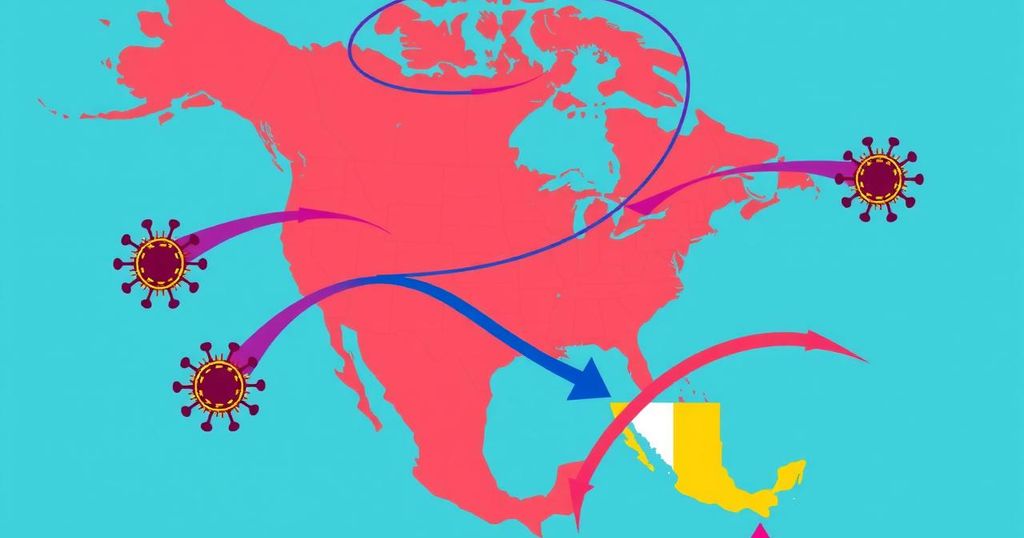World news
AMERICAS, ARGENTINA, ASIA, BELIZE, CANADA, CHIHUAHUA, CIUDAD JUAREZ, COVID-19, DISEASE, EL PASO, HECTOR OCARANZA, JAR, JARBAS BARBOSA, JUAREZ, LET, LETICIA RUÍZ, MEXICO, NATURAL DISASTERS, NEW BRUNSWICK, NEW MEXICO, NORTH AMERICA, OCARANZA, ONTARIO, PAN AMERICAN HEALTH ORGANIZATION, PANDEMIC, PHILIPPINES, PREVENTION AND DISEASE CONTROL, PUBLIC HEALTH, SEMINOLE, SOUTH AMERICA, TEXAS, U. S, UNITED STATES, US, WEST TEXAS, WORLD HEALTH ORGANIZATION
Daniel O'Connor
0 Comments
Measles Outbreak Surges Across North America Amidst Cross-Border Spread
Measles outbreaks in North America, particularly in El Paso, Ciudad Juarez, and Ontario, have surged, with over 2,500 cases reported. The virus’s spread is linked to Mennonite communities, highlighting gaps in vaccination rates that have fallen below the 95% threshold needed to prevent disease spread. Efforts to contain the outbreaks include vaccination clinics offering free shots. Health officials express concerns over cross-border mobility contributing to the crisis.
In recent weeks, North America has witnessed an alarming rise in measles cases, with significant outbreaks reported in Canada, the United States, and Mexico. Dr. Hector Ocaranza, who oversees public health in El Paso, anticipated the spread to his city once measles began its trajectory through West Texas and eastern New Mexico. El Paso is conveniently connected to the ongoing outbreaks with direct routes frequently traveled by families and commercial truckers crossing into Mexico and back.
“Diseases know no borders,” stated Dr. Ocaranza. He pointed out how mobile populations can lead to the spreading of infections across boundaries. With 38 reported measles cases in El Paso, the city now holds the second-highest count in Texas outside the epicenter area. Ciudad Juarez, just across the border, reports 14 cases as of the latest update.
The current situation reflects a larger trend in North America, where the three most significant measles outbreaks have accumulated over 2,500 cases. This issue has turned dire, with three fatalities confirmed in the U.S. and one in Mexico. The epidemic traces its origins back to Ontario, Canada during the fall, with cases surging in Texas and New Mexico beginning late January, and later in Chihuahua state where the count has reached 786 since mid-February.
Health officials have identified Mennonite communities as central to the spread. These groups have familial links traced from Canada, through Mexico, and into Texas’ Seminole region. The first identified case in Chihuahua reportedly began with a child visiting family in Seminole who then unknowingly passed the virus at school. Simultaneously, Ontario health officials have noted that their outbreak stemmed from a large gathering involving similar Mennonite groups.
Leticia Ruíz, the director of prevention and disease control in Chihuahua, emphasized, “This virus was imported, traveling country to country.” The linked cases spread not only across borders but also reflect a troubling lapse in maintained vaccination rates, which are supposed to be at 95% to effectively combat measles outbreaks, according to Dr. Jarbas Barbosa from the Pan American Health Organization.
The World Health Organization’s recent findings are alarming. They show that measles activity in the Americas has increased elevenfold from the previous year, with a heightened risk level flagged in comparison to the global average. Currently, confirmed measles cases span six countries: Argentina, Belize, Brazil, Canada, the United States, and Mexico, straining local health resources.
Investigating outbreaks is no small task. Dr. David Sugerman from the CDC estimated the response cost per measles case alone can reach $30,000 to $50,000. However, there is a distinct separation in cases from Ciudad Juarez, which reportedly do not connect directly to the Mennonite community’s outbreak. In El Paso, over half of the cases are among adults, which is unusual, indicating a shift in affected demographics, with at least three hospitalizations recorded.
In response, health departments are hosting vaccination clinics in various public venues, offering free vaccinations regardless of residency. Dr. Ocaranza noted that communication has been effective across the U.S.-Mexico border despite being informal, allowing rapid responses to cases. Rogelio Covarrubias, a health official in Juarez, raised the alarm about the potential for more infections due to high traveler turnover.
In Michigan, a small outbreak of four cases in Montcalm County has been traced back to Ontario, intensifying local health officials’ concerns. “If we think about measles as a forest fire, we’ve got these burning embers that are floating in the air right now,” explained Dr. Natasha Bagdasarian, Michigan’s chief medical executive. The uneven vaccination rates in certain areas, with only 30% in some schools vaccinated, pose a significant risk for further spread.
As the situation persists, particularly in Canada, public health officials are tirelessly monitoring case counts. Alberta has reported 83 cases, while Ontario has experienced the worst of it with 1,020 as of recently, mainly concentrated in areas near Michigan. Easter Sunday saw public exposure announcements related to Mennonite churches, raising further alarm across health departments. Dr. Sarah Wilson from Public Health Ontario succinctly expressed the struggle: “It sometimes feels like we’re just behind, always trying to catch up to measles.”
The measles outbreaks across North America have highlighted the vulnerabilities in vaccination rates and the risks posed by cross-border mobility. Threats from serious illness are rising, particularly among specific communities. Increased vaccination efforts and communication between health departments will be critical as health officials work to contain and resolve the ongoing crisis in the region.
Original Source: www.usnews.com




Post Comment